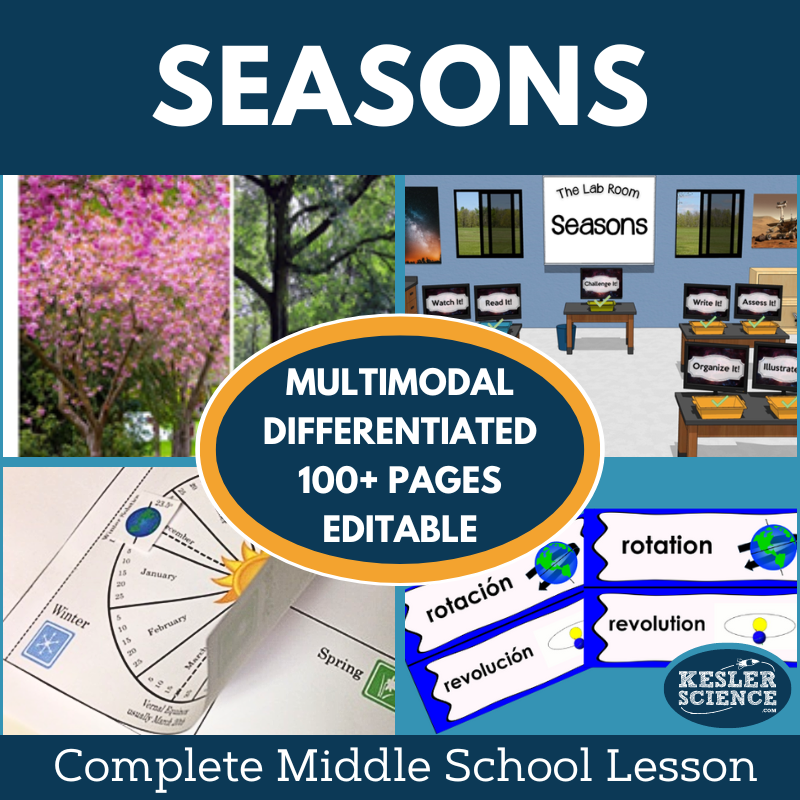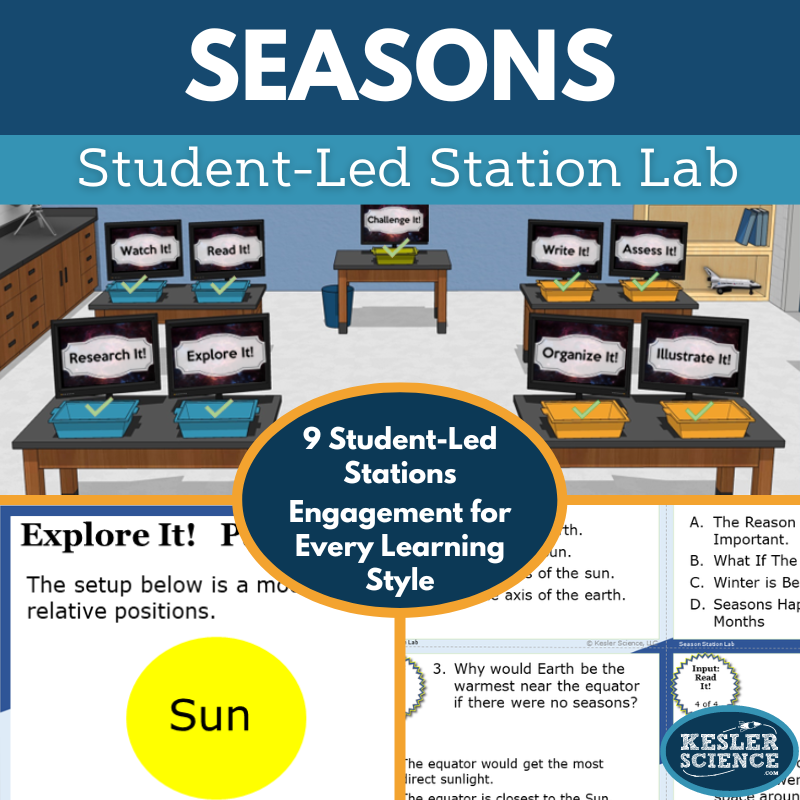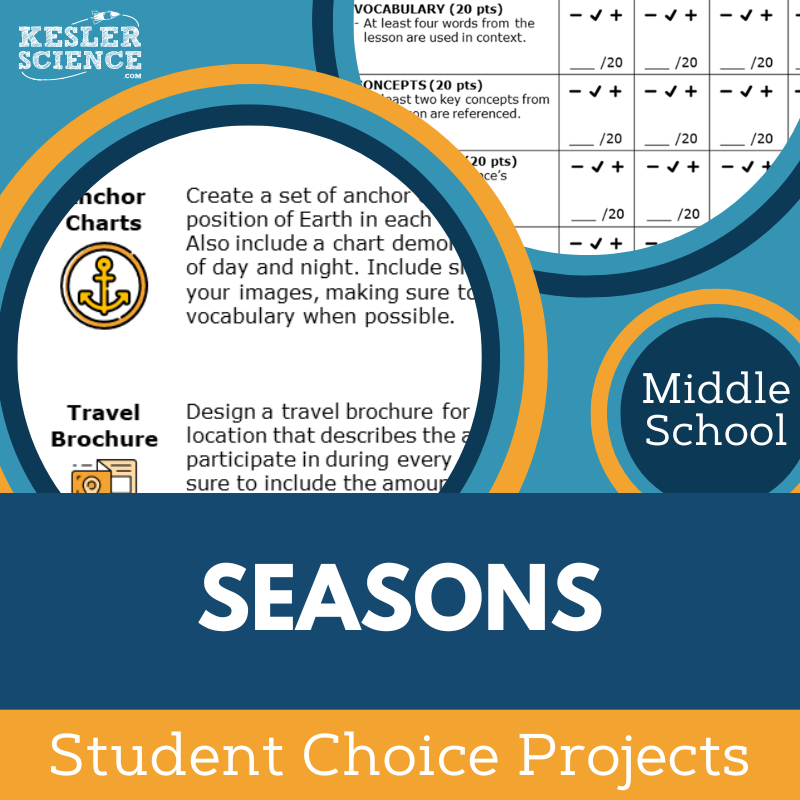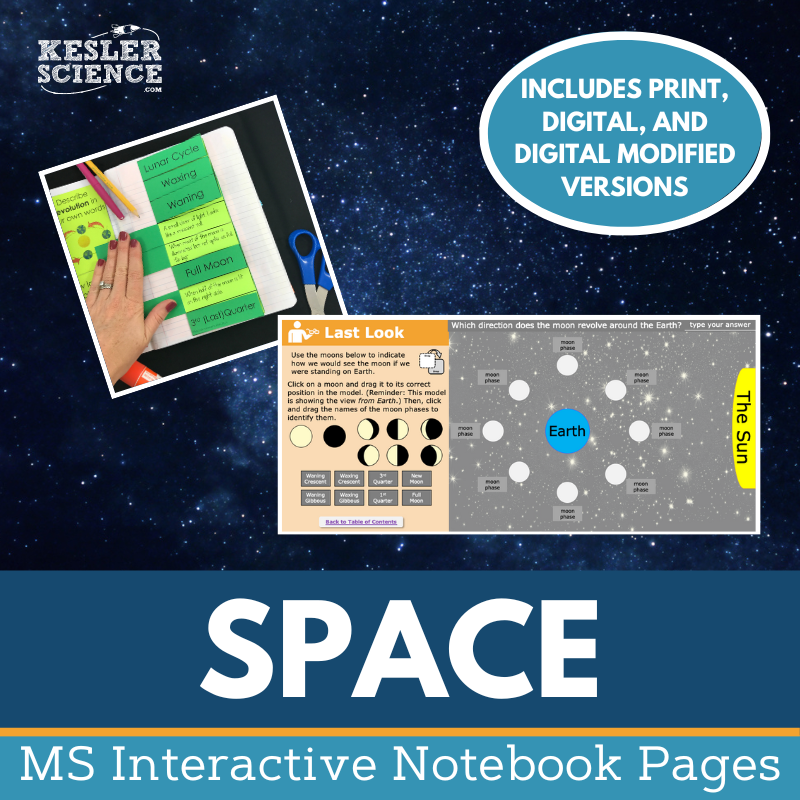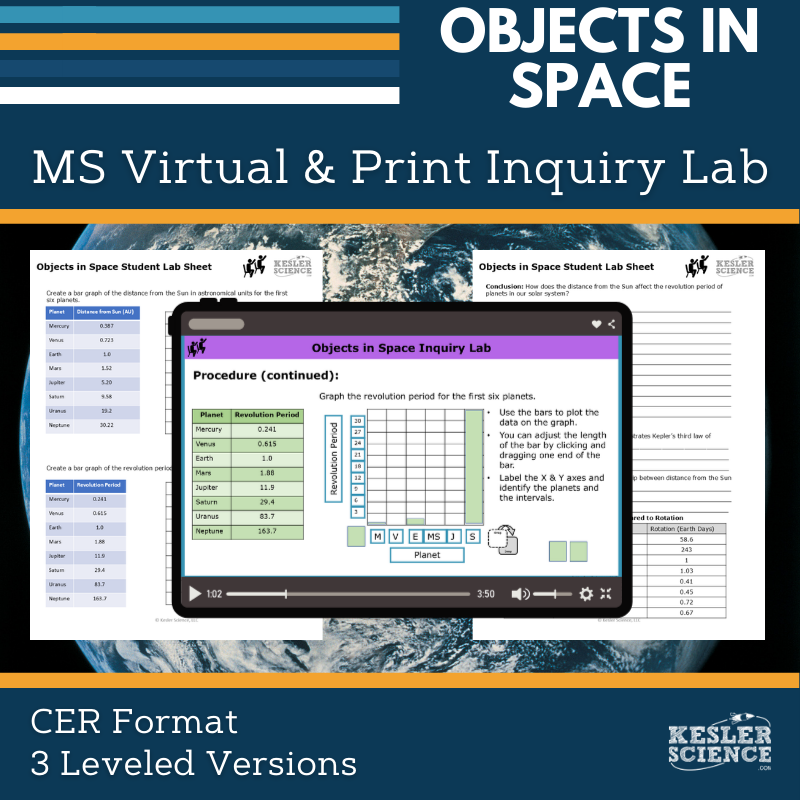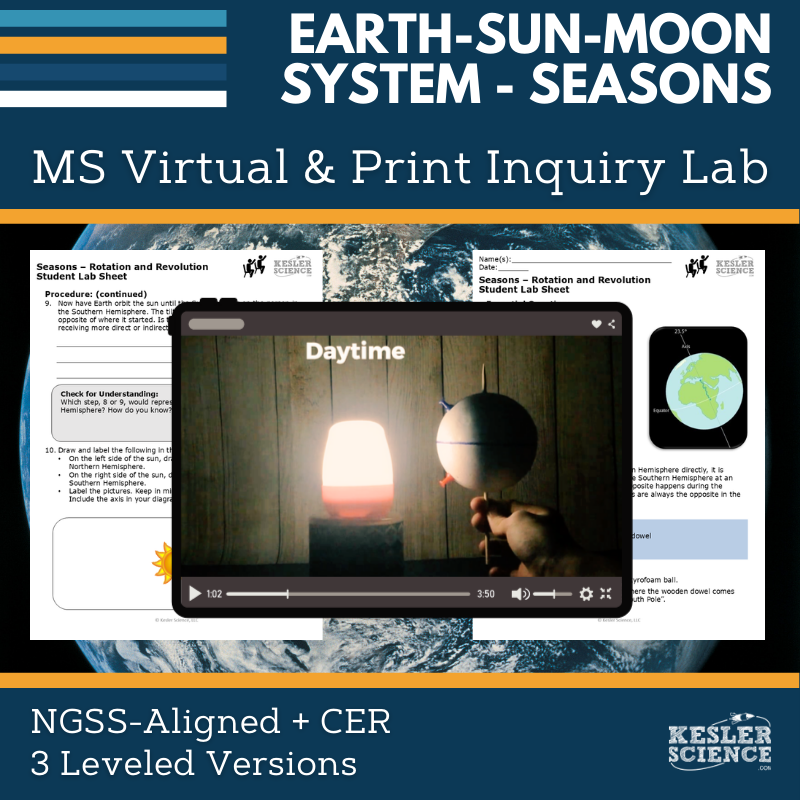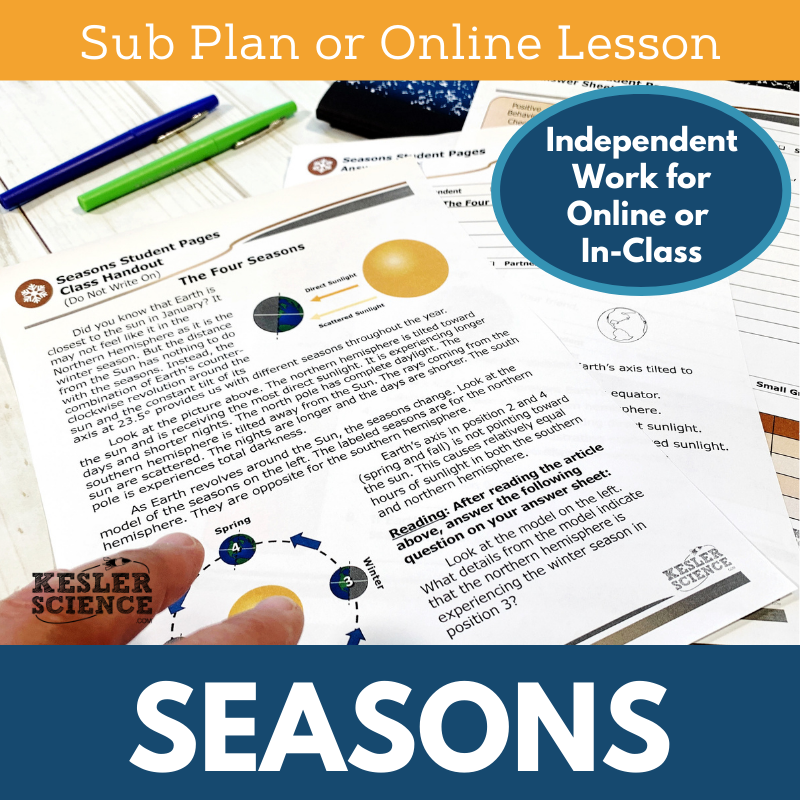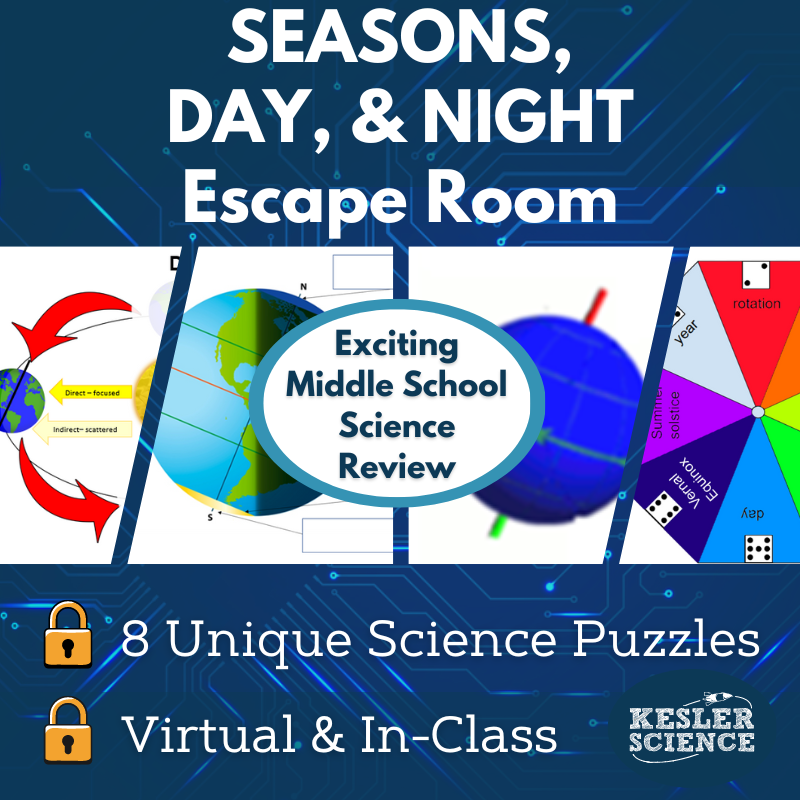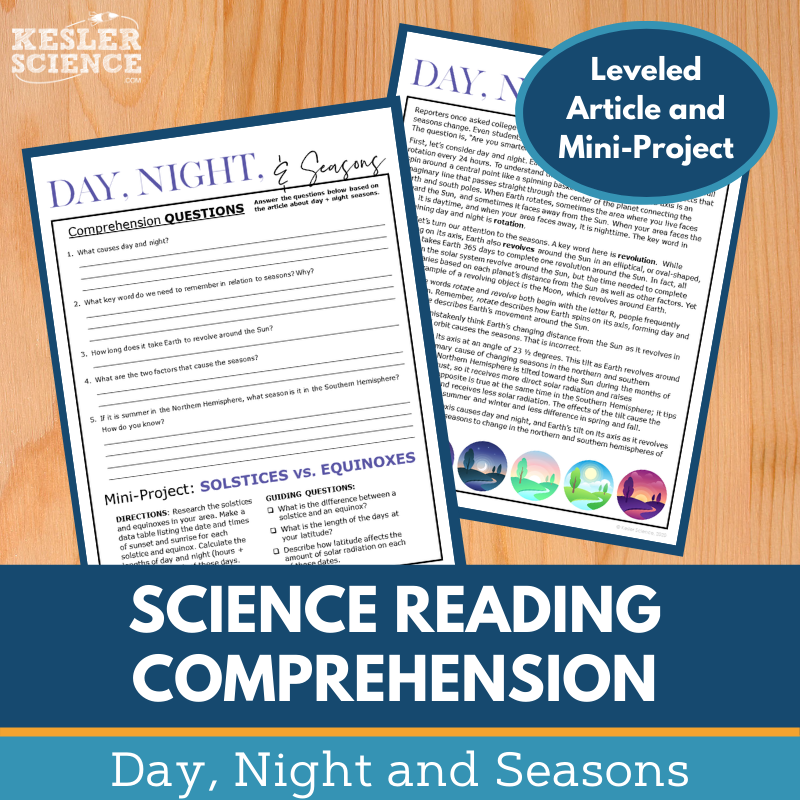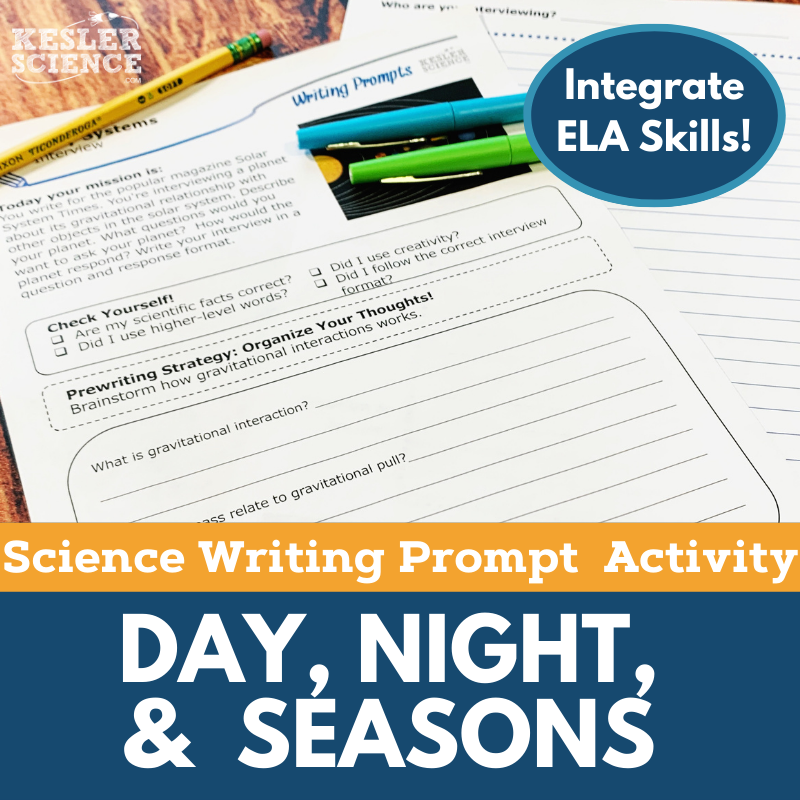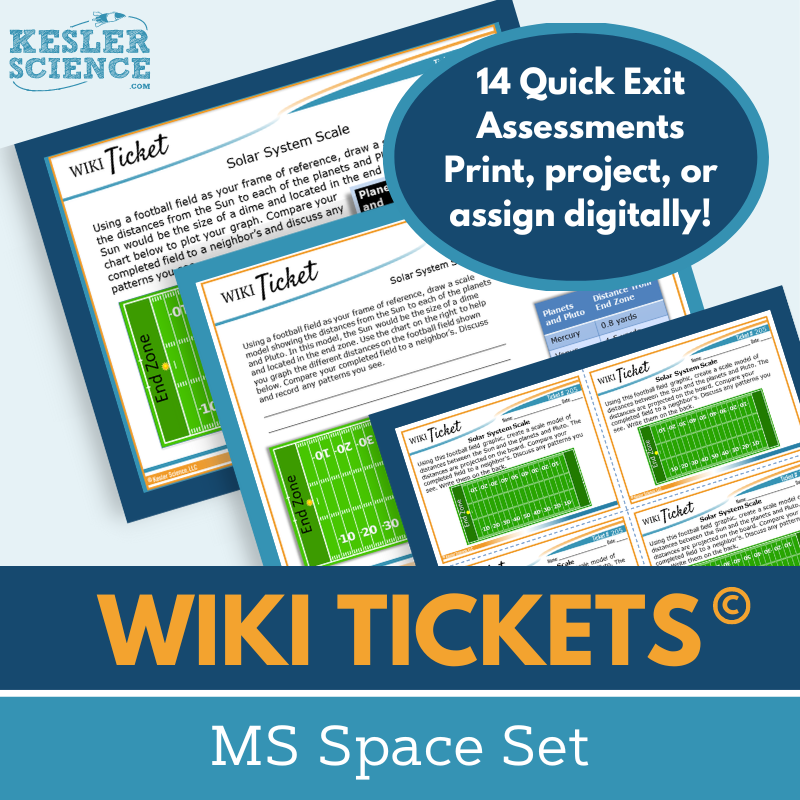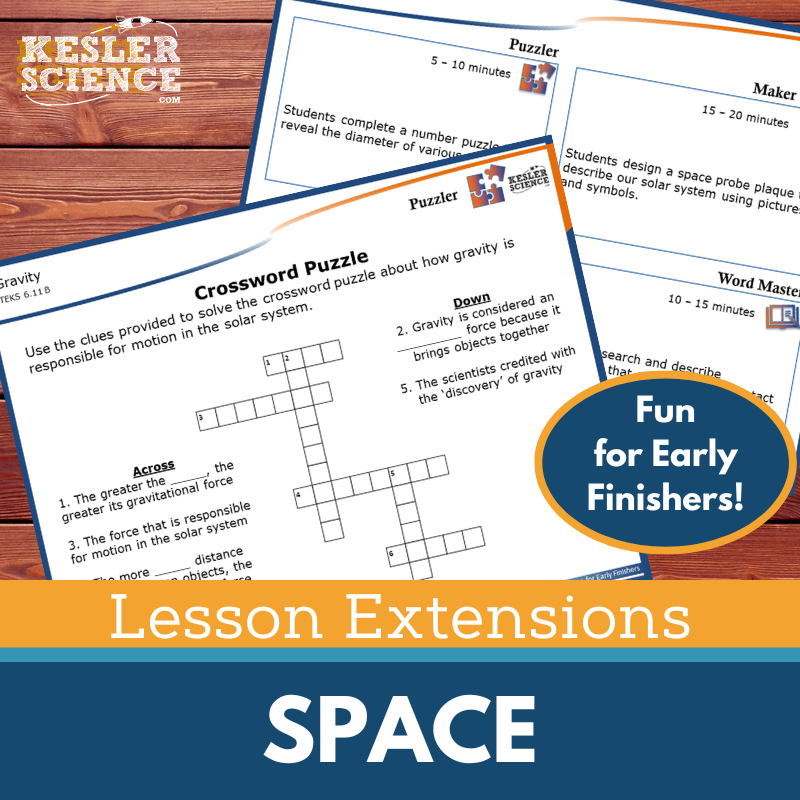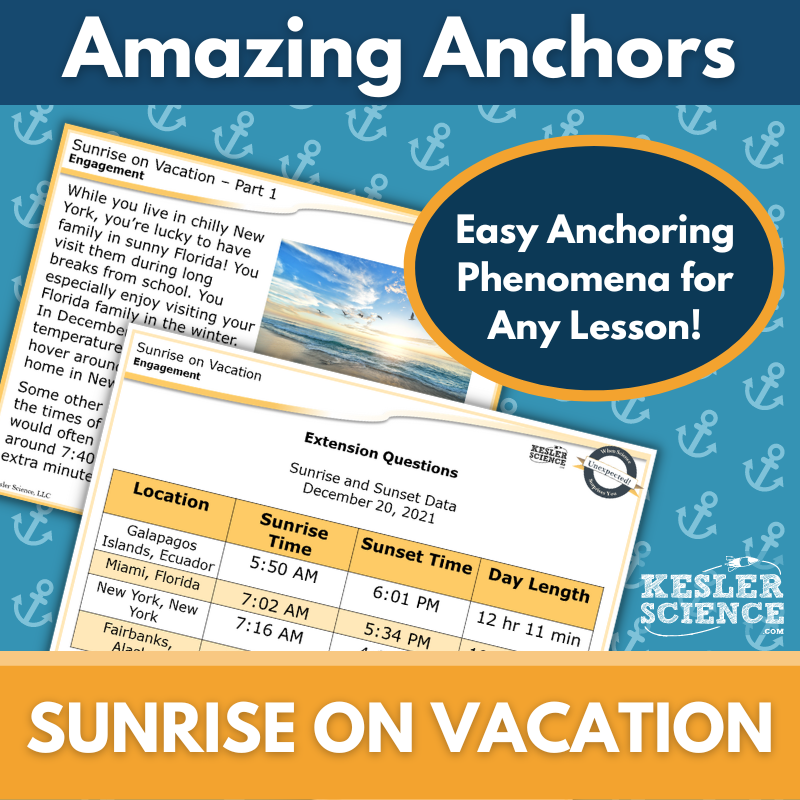Seasons Activities for Middle School Science
The Kesler Science Complete 5E Lesson on Seasons and the causes of day and night offers a comprehensive, student-centered experience that helps middle school learners understand Earth's rotation, revolution, and seasonal changes. The resources below will give students a comprehensive understanding of seasons. All of the following materials are also included in the Kesler Science Membership.
The Kesler Science Complete 5E Lesson on Seasons and the causes of day and night is an engaging, student-centered unit designed for middle school students. This flexible, fully editable lesson includes presentations, worksheets, and assessment materials with differentiated content to cater to all learning levels. With minimal prep, it allows teachers to focus on student success while incorporating a variety of learning formats—both printable and digital. It’s ideal for in-person or virtual classrooms, with Spanish translations included for key materials.
Following the 5E Model, the lesson begins with Engagement, introducing key concepts through vocabulary cards and class discussions. The Exploration phase includes a student-led station lab with nine stations, each offering a different approach to understanding the seasons. From hands-on activities and reading passages to research tasks and videos, the exploration stations cater to a variety of learning styles. Output stations like “Write It!” and “Illustrate It!” give students opportunities to demonstrate their knowledge creatively.
In the Explanation phase, editable PowerPoints and interactive notebooks reinforce content through guided notes and student interaction. Elaboration extends learning with student-choice projects, and the lesson concludes with Evaluation, offering standards-aligned assessment questions. This comprehensive, differentiated lesson keeps students engaged while deepening their understanding of Earth’s rotation, revolution, and seasonal changes.
The Kesler Science Complete 5E Lesson on Seasons and the causes of day and night is an engaging, student-centered unit designed for middle school students. This flexible, fully editable lesson includes presentations, worksheets, and assessment materials with differentiated content to cater to all learning levels. With minimal prep, it allows teachers to focus on student success while incorporating a variety of learning formats—both printable and digital. It’s ideal for in-person or virtual classrooms, with Spanish translations included for key materials.
Following the 5E Model, the lesson begins with Engagement, introducing key concepts through vocabulary cards and class discussions. The Exploration phase includes a student-led station lab with nine stations, each offering a different approach to understanding the seasons. From hands-on activities and reading passages to research tasks and videos, the exploration stations cater to a variety of learning styles. Output stations like “Write It!” and “Illustrate It!” give students opportunities to demonstrate their knowledge creatively.
In the Explanation phase, editable PowerPoints and interactive notebooks reinforce content through guided notes and student interaction. Elaboration extends learning with student-choice projects, and the lesson concludes with Evaluation, offering standards-aligned assessment questions. This comprehensive, differentiated lesson keeps students engaged while deepening their understanding of Earth’s rotation, revolution, and seasonal changes.
The Kesler Science Seasons Station Lab offers a student-led, modular learning experience, perfect for keeping middle schoolers engaged as they explore Earth's rotation, revolution, and the causes of the seasons. With differentiated activities, this station lab allows students to take control of their learning while teachers facilitate the process. The nine stations include hands-on tasks, readings, and multimedia resources to engage students in understanding the seasons.
Each station includes input and output activities to deepen student understanding. Input stations, such as "Explore It!" and "Watch It!" provide multimodal ways to interact with the content through hands-on demonstrations, research, reading passages, and videos. Output stations like "Illustrate It!" and "Write It!" allow students to apply their learning creatively through drawing models, writing short answers, and completing tasks that demonstrate their knowledge.
Additionally, the lab includes a Challenge It! station for early finishers, offering extended learning opportunities through games, crosswords, and mini-projects. This resource is highly flexible and can be used in both in-person and virtual learning environments, with digital versions available for tasks like manipulating images and text in PowerPoint or Google Slides.
The Kesler Science Seasons Station Lab offers a student-led, modular learning experience, perfect for keeping middle schoolers engaged as they explore Earth's rotation, revolution, and the causes of the seasons. With differentiated activities, this station lab allows students to take control of their learning while teachers facilitate the process. The nine stations include hands-on tasks, readings, and multimedia resources to engage students in understanding the seasons.
Each station includes input and output activities to deepen student understanding. Input stations, such as "Explore It!" and "Watch It!" provide multimodal ways to interact with the content through hands-on demonstrations, research, reading passages, and videos. Output stations like "Illustrate It!" and "Write It!" allow students to apply their learning creatively through drawing models, writing short answers, and completing tasks that demonstrate their knowledge.
Additionally, the lab includes a Challenge It! station for early finishers, offering extended learning opportunities through games, crosswords, and mini-projects. This resource is highly flexible and can be used in both in-person and virtual learning environments, with digital versions available for tasks like manipulating images and text in PowerPoint or Google Slides.
The Kesler Science Seasons Student Choice Projects provide middle school students with a variety of project options, allowing them to select the one that best fits their learning style and interests. Students can choose from six pre-designed projects or create their own, fostering creativity and personalized learning. A grading rubric is included, and it can be modified to meet specific assessment needs, whether by teachers, peers, or students themselves.
These projects are flexible and adaptable for diverse learning needs. There are two versions of the project page: one for students needing extra support, with simplified project options, and another for those seeking more of a challenge. Teachers can assign combinations of projects and still use the same rubric for assessment.
The resources include a choice board with nine project options and a “design your own” project, along with teacher directions for guidance. The projects require standard classroom supplies like paper, markers, and scissors, and many can also be completed digitally. Some projects may benefit from crafting supplies for building models, but most rely on common materials.
The Kesler Science Seasons Student Choice Projects provide middle school students with a variety of project options, allowing them to select the one that best fits their learning style and interests. Students can choose from six pre-designed projects or create their own, fostering creativity and personalized learning. A grading rubric is included, and it can be modified to meet specific assessment needs, whether by teachers, peers, or students themselves.
These projects are flexible and adaptable for diverse learning needs. There are two versions of the project page: one for students needing extra support, with simplified project options, and another for those seeking more of a challenge. Teachers can assign combinations of projects and still use the same rubric for assessment.
The resources include a choice board with nine project options and a “design your own” project, along with teacher directions for guidance. The projects require standard classroom supplies like paper, markers, and scissors, and many can also be completed digitally. Some projects may benefit from crafting supplies for building models, but most rely on common materials.
The Kesler Science Space Science Interactive Notebook is an engaging resource for teachers looking to create interactive learning experiences for their students. It includes both print and digital versions, making it perfect for traditional classrooms, 1:1 environments, or distance learning.
The bundle covers key space science topics such as asteroids, meteors, and comets, the Big Bang theory, eclipses, the electromagnetic spectrum, galaxies, and more. The digital version features a PowerPoint interactive notebook, which can be uploaded to Google Slides or learning management systems like MS Teams or Canvas. Reflection pages and space for students to take notes are included, along with a teacher answer key and modified versions for students with accommodations.
The print version provides a full set of blank templates for students, pre-filled templates for those needing modifications, and color photos to illustrate how each template should be used. This bundle is designed to support differentiated learning and keep students engaged in key space science concepts.
The Kesler Science Space Science Interactive Notebook is an engaging resource for teachers looking to create interactive learning experiences for their students. It includes both print and digital versions, making it perfect for traditional classrooms, 1:1 environments, or distance learning.
The bundle covers key space science topics such as asteroids, meteors, and comets, the Big Bang theory, eclipses, the electromagnetic spectrum, galaxies, and more. The digital version features a PowerPoint interactive notebook, which can be uploaded to Google Slides or learning management systems like MS Teams or Canvas. Reflection pages and space for students to take notes are included, along with a teacher answer key and modified versions for students with accommodations.
The print version provides a full set of blank templates for students, pre-filled templates for those needing modifications, and color photos to illustrate how each template should be used. This bundle is designed to support differentiated learning and keep students engaged in key space science concepts.
The Objects in Space Inquiry Lab aligns with the NGSS standard and engages students in exploring how the distance of a planet from the Sun affects its period of revolution. Through four distinct lab options, students analyze orbital distances and revolutionary periods, with one lab even taking place outside for hands-on measurements. After data analysis, students apply their understanding by making predictions about other planets in the solar system.
This resource includes three differentiated versions—dependent, modified, and independent—to support diverse learning needs. Each version is available in both print and digital formats, making it flexible for classroom or remote learning. Comprehension questions, C.E.R. prompts, and a reflection section are built into every version to encourage deeper thinking and science communication skills.
Printable labs require simple materials like yarn and colored pencils, while the digital version needs no materials and offers interactive experiences within a PowerPoint file. Editable files, teacher directions, answer keys, and compatibility with Google Slides ensure the lab is easy to implement and adapt to any classroom setting.
The Objects in Space Inquiry Lab aligns with the NGSS standard and engages students in exploring how the distance of a planet from the Sun affects its period of revolution. Through four distinct lab options, students analyze orbital distances and revolutionary periods, with one lab even taking place outside for hands-on measurements. After data analysis, students apply their understanding by making predictions about other planets in the solar system.
This resource includes three differentiated versions—dependent, modified, and independent—to support diverse learning needs. Each version is available in both print and digital formats, making it flexible for classroom or remote learning. Comprehension questions, C.E.R. prompts, and a reflection section are built into every version to encourage deeper thinking and science communication skills.
Printable labs require simple materials like yarn and colored pencils, while the digital version needs no materials and offers interactive experiences within a PowerPoint file. Editable files, teacher directions, answer keys, and compatibility with Google Slides ensure the lab is easy to implement and adapt to any classroom setting.
The Seasons Inquiry Lab aligns with NGSS MS-ESS1-1 and guides students in building a model to explain the cause of Earth's seasons. Learners explore the Earth-Sun relationship through either a hands-on lab or an interactive virtual version that includes a full video demonstration. Both formats include comprehension questions, C.E.R. prompts, and a reflection section to support deep understanding.
Each version of the lab is offered at three levels—Modified, Dependent, and Independent—to support a range of learners. The Modified version provides structured support with simplified tasks and sentence stems, while the Dependent version blends step-by-step instructions with guided inquiry. The Independent version encourages advanced students to take ownership of their learning through open-ended modeling and minimal guidance.
The print lab uses materials like a Styrofoam ball, flashlight, and push pins for physical modeling, while the digital version can be used without any supplies, making it ideal for remote or absent students. Editable files, answer keys, and teacher guides ensure maximum flexibility and easy classroom integration.
The Seasons Inquiry Lab aligns with NGSS MS-ESS1-1 and guides students in building a model to explain the cause of Earth's seasons. Learners explore the Earth-Sun relationship through either a hands-on lab or an interactive virtual version that includes a full video demonstration. Both formats include comprehension questions, C.E.R. prompts, and a reflection section to support deep understanding.
Each version of the lab is offered at three levels—Modified, Dependent, and Independent—to support a range of learners. The Modified version provides structured support with simplified tasks and sentence stems, while the Dependent version blends step-by-step instructions with guided inquiry. The Independent version encourages advanced students to take ownership of their learning through open-ended modeling and minimal guidance.
The print lab uses materials like a Styrofoam ball, flashlight, and push pins for physical modeling, while the digital version can be used without any supplies, making it ideal for remote or absent students. Editable files, answer keys, and teacher guides ensure maximum flexibility and easy classroom integration.
The Kesler Science Seasons Sub Plans include a complete lesson that guides students through engaging activities, including a warm-up puzzle, reading passage, model creation, letter-writing task, and a seasonal characteristics puzzle. Students explore the Earth-Sun relationship during different seasons and explain these concepts to someone in the Southern Hemisphere. Extension activities for early finishers, such as creating a quiz or holiday card, add flexibility to the lesson.
The lesson is fully prepared for substitutes, with detailed instructions, answer keys, and behavior check-points to ensure smooth classroom management. A distance learning version is available with a student-only PDF and a Google Form answer sheet, making this lesson adaptable for remote learning environments.
The sub plans are designed to be student-centered, with clear expectations and engaging activities. Whether used for substitute teachers, remote learning, or extra credit, the lesson is easily customizable and provides everything needed for a seamless classroom experience, including editable versions of documents and a student PDF for use with PDF editors.
The Kesler Science Seasons Sub Plans include a complete lesson that guides students through engaging activities, including a warm-up puzzle, reading passage, model creation, letter-writing task, and a seasonal characteristics puzzle. Students explore the Earth-Sun relationship during different seasons and explain these concepts to someone in the Southern Hemisphere. Extension activities for early finishers, such as creating a quiz or holiday card, add flexibility to the lesson.
The lesson is fully prepared for substitutes, with detailed instructions, answer keys, and behavior check-points to ensure smooth classroom management. A distance learning version is available with a student-only PDF and a Google Form answer sheet, making this lesson adaptable for remote learning environments.
The sub plans are designed to be student-centered, with clear expectations and engaging activities. Whether used for substitute teachers, remote learning, or extra credit, the lesson is easily customizable and provides everything needed for a seamless classroom experience, including editable versions of documents and a student PDF for use with PDF editors.
The Kesler Science Seasons, Day, and Night Escape Room provides an exciting and immersive way for middle school students to demonstrate their knowledge of rotation, revolution, seasons, and day and night. This engaging experience includes eight puzzles that can be selected and customized by the teacher, offering flexibility for different class periods. Each puzzle is independent, allowing for easy adjustments based on time and classroom needs.
Teachers can choose between a low-cost option using manila envelopes or a more authentic escape room setup with locks and a storage box. All necessary materials, including printed puzzle sheets, brads, and invisible ink, are provided. Additionally, there are digital versions of the escape room that can be assigned through email or Google Classroom, allowing for virtual learning opportunities.
The product includes teacher directions, a detailed answer key, and various interactive resources such as a video challenge, digital answer sheet, and editable teacher version. With over 50 prize ideas and reward templates, this escape room activity offers an engaging and fun way to reinforce key science concepts.
The Kesler Science Seasons, Day, and Night Escape Room provides an exciting and immersive way for middle school students to demonstrate their knowledge of rotation, revolution, seasons, and day and night. This engaging experience includes eight puzzles that can be selected and customized by the teacher, offering flexibility for different class periods. Each puzzle is independent, allowing for easy adjustments based on time and classroom needs.
Teachers can choose between a low-cost option using manila envelopes or a more authentic escape room setup with locks and a storage box. All necessary materials, including printed puzzle sheets, brads, and invisible ink, are provided. Additionally, there are digital versions of the escape room that can be assigned through email or Google Classroom, allowing for virtual learning opportunities.
The product includes teacher directions, a detailed answer key, and various interactive resources such as a video challenge, digital answer sheet, and editable teacher version. With over 50 prize ideas and reward templates, this escape room activity offers an engaging and fun way to reinforce key science concepts.
In the Kesler Science Day, Night, and Seasons reading comprehension activity, students explore the causes of day, night, and seasons through a nonfiction article. After reading, students complete comprehension questions and research solstices and equinoxes, deepening their understanding of these concepts. The passage is leveled for middle school students, with Lexile levels ranging from 1100 to 1300, making it suitable for grades 6-8 and advanced 5th graders.
The resource includes engaging, colorful graphics and a hands-on mini-project, designed to boost reading comprehension and science literacy. A Cornell notes template is also provided to support students in organizing their thoughts.
The lesson is perfect for both in-class and virtual learning, with files compatible for platforms like Google Classroom and MS Teams. The versatile materials can be used for absent students, extra credit, sub plans, or whole-class instruction, making it a valuable resource for any classroom setting.
In the Kesler Science Day, Night, and Seasons reading comprehension activity, students explore the causes of day, night, and seasons through a nonfiction article. After reading, students complete comprehension questions and research solstices and equinoxes, deepening their understanding of these concepts. The passage is leveled for middle school students, with Lexile levels ranging from 1100 to 1300, making it suitable for grades 6-8 and advanced 5th graders.
The resource includes engaging, colorful graphics and a hands-on mini-project, designed to boost reading comprehension and science literacy. A Cornell notes template is also provided to support students in organizing their thoughts.
The lesson is perfect for both in-class and virtual learning, with files compatible for platforms like Google Classroom and MS Teams. The versatile materials can be used for absent students, extra credit, sub plans, or whole-class instruction, making it a valuable resource for any classroom setting.
The Kesler Science Day, Night, and Seasons Science Writing Prompt Activity provides middle school students with engaging materials to deepen their understanding of earth science. By using songwriting as a creative approach, this activity encourages students to explore scientific concepts while enhancing their writing skills. The resources are perfect for both in-person and virtual learning environments, ensuring students stay engaged regardless of their setting.
This low-prep, student-centered writing activity is ideal for elaboration or review and pairs well with other Kesler Science products. It encourages students to make connections and communicate their understanding in a fun and creative way.
Included are teacher directions, full and half-sheet rubrics, a projection version, and both printed and digital handouts. The activity is designed to be flexible, offering multiple uses such as cross-curricular projects, formative assessments, and differentiated exercises.
The Kesler Science Day, Night, and Seasons Science Writing Prompt Activity provides middle school students with engaging materials to deepen their understanding of earth science. By using songwriting as a creative approach, this activity encourages students to explore scientific concepts while enhancing their writing skills. The resources are perfect for both in-person and virtual learning environments, ensuring students stay engaged regardless of their setting.
This low-prep, student-centered writing activity is ideal for elaboration or review and pairs well with other Kesler Science products. It encourages students to make connections and communicate their understanding in a fun and creative way.
Included are teacher directions, full and half-sheet rubrics, a projection version, and both printed and digital handouts. The activity is designed to be flexible, offering multiple uses such as cross-curricular projects, formative assessments, and differentiated exercises.
The Kesler Science Space WIKI Tickets are engaging formative assessments designed for 6th-8th grade science topics, offering multiple flexible formats to check student understanding. Each topic in the Space Set includes five versions: full-screen display, three handout sizes (full, split, and quarter-page), and a digital interactive option that can be used as an editable PowerPoint or Google Slides file.
These assessments are aligned with NGSS and TEKS middle school science standards, with some topics featuring multiple tickets. Each set also includes a bonus table of contents file to show standard alignment, ensuring a comprehensive understanding of the covered topics.
Perfect for both in-class and remote learning, WIKI Tickets can be used as exit tickets, bellringers, or anytime you need to gauge students' progress. Whether projected on a screen or completed digitally, these colorful and engaging assessments provide valuable insight into student comprehension of key space science topics such as the lunar cycle, solar system properties, and space exploration.
The Kesler Science Space WIKI Tickets are engaging formative assessments designed for 6th-8th grade science topics, offering multiple flexible formats to check student understanding. Each topic in the Space Set includes five versions: full-screen display, three handout sizes (full, split, and quarter-page), and a digital interactive option that can be used as an editable PowerPoint or Google Slides file.
These assessments are aligned with NGSS and TEKS middle school science standards, with some topics featuring multiple tickets. Each set also includes a bonus table of contents file to show standard alignment, ensuring a comprehensive understanding of the covered topics.
Perfect for both in-class and remote learning, WIKI Tickets can be used as exit tickets, bellringers, or anytime you need to gauge students' progress. Whether projected on a screen or completed digitally, these colorful and engaging assessments provide valuable insight into student comprehension of key space science topics such as the lunar cycle, solar system properties, and space exploration.
The Kesler Science Space Lesson Extensions provide engaging activities designed to challenge fast finishers and deepen student learning. These critical thinking tasks are connected to NGSS and TEKS space standards, offering rigorous but fun opportunities to explore topics in greater depth. With activities like puzzles, hands-on maker space tasks, tech connections, and creative word writing, these extensions promote STEAM skills and digital literacy.
The Lesson Extensions are structured to provide flexible support for teachers, with clear directions, answer keys, and both digital and paper versions. These materials help reinforce the lesson’s core concepts while offering ways to engage students during testing or other gaps in the schedule.
Perfect for independent learners, these activities push students to apply their knowledge creatively while connecting it to real-world applications. The extensions cover a variety of space science topics, including gravity, space travel, and the lunar cycle, providing additional challenges that extend the learning experience beyond the standard lesson.
The Kesler Science Space Lesson Extensions provide engaging activities designed to challenge fast finishers and deepen student learning. These critical thinking tasks are connected to NGSS and TEKS space standards, offering rigorous but fun opportunities to explore topics in greater depth. With activities like puzzles, hands-on maker space tasks, tech connections, and creative word writing, these extensions promote STEAM skills and digital literacy.
The Lesson Extensions are structured to provide flexible support for teachers, with clear directions, answer keys, and both digital and paper versions. These materials help reinforce the lesson’s core concepts while offering ways to engage students during testing or other gaps in the schedule.
Perfect for independent learners, these activities push students to apply their knowledge creatively while connecting it to real-world applications. The extensions cover a variety of space science topics, including gravity, space travel, and the lunar cycle, providing additional challenges that extend the learning experience beyond the standard lesson.
This Amazing Anchors Phenomenon Lesson introduces and reinforces the science behind Earth’s day, night, and seasons through real-world connections. Students begin with an introductory reading that explores sunrise and sunset times across locations, followed by comprehension and extension questions that encourage deeper thinking and prepare students for further learning. A second, explanatory reading helps break down the concepts behind Earth’s rotation and revolution in a student-friendly way, supported by additional comprehension and reinforcement questions.
The resource includes teacher directions with answer keys, editable materials, projection slides, and both print and digital versions for flexible classroom use. It is TEKS-aligned and available in full- and half-sheet formats that can be added to interactive notebooks. A differentiated version is also provided, with sentence starters and scaffolded language to support diverse learners.
Designed to bookend a core science lesson, these materials are ideal for the Engagement and Elaboration phases of the 5E Model. Whether used in-person or virtually, this no-prep activity helps students make meaningful connections to how Earth's motion causes observable patterns like day, night, and seasonal changes.
This Amazing Anchors Phenomenon Lesson introduces and reinforces the science behind Earth’s day, night, and seasons through real-world connections. Students begin with an introductory reading that explores sunrise and sunset times across locations, followed by comprehension and extension questions that encourage deeper thinking and prepare students for further learning. A second, explanatory reading helps break down the concepts behind Earth’s rotation and revolution in a student-friendly way, supported by additional comprehension and reinforcement questions.
The resource includes teacher directions with answer keys, editable materials, projection slides, and both print and digital versions for flexible classroom use. It is TEKS-aligned and available in full- and half-sheet formats that can be added to interactive notebooks. A differentiated version is also provided, with sentence starters and scaffolded language to support diverse learners.
Designed to bookend a core science lesson, these materials are ideal for the Engagement and Elaboration phases of the 5E Model. Whether used in-person or virtually, this no-prep activity helps students make meaningful connections to how Earth's motion causes observable patterns like day, night, and seasonal changes.
Year-Round Resources
These year-round activities will increase your students' understanding of many middle school science topics. All of these activities are also included in the Kesler Science Membership.
Visual Data & Graphing
You're not alone if your students struggle with understanding graphs, charts, and tables. It's a skill that takes an enormous amount of practice. This resource will help students build a strong foundation in analyzing data and creating their own data visualizations.
Bell Ringers and Warm-Ups
These middle school science bell ringers are an excellent way to engage your students as soon as they walk into your classroom. This comprehensive FULL YEAR resource includes everything you need to start off each science class with an interesting warm-up activity.
Review Board Games
Each game board has been carefully designed to keep students engaged. There are 10 different action spaces on each board and dozens of question cards. All of the actions are related to science concepts and keep the students motivated throughout the game.
Each game is ready to play. Simply print out the board and the cards and let the students enjoy reviewing nine different units.
Essential Questions
Below are the essential questions associated with the lessons and activities included in this unit. This topic is only one of more than 100 middle school science topics included in the Kesler Science Membership.
-
What causes day and night?
-
What causes the seasons to change?
Kesler Science Membership
Imagine never having to search for another middle school science lesson again. The membership gives you access to ALL of the Kesler Science products in one place (Yes, including everything above).
Say goodbye to long hours of lesson prep.

